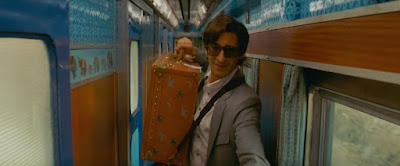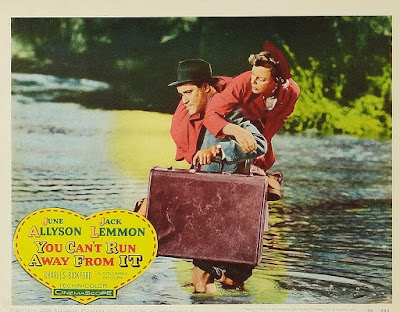Comedy can be unpacked from a standard travel bag, including a suitcase, a trunk, a duffel bag or a backpack. Filmmakers realized this fact early on.
 |
| Roscoe Arbuckle and Buster Keaton and in The Bell Boy (1918) |
 |
| Bebe Daniels and Harold Lloyd |
Two mysterious individuals, Blouie and Zowie, with a suitcase full of money, fall prey to Jerry [George Ovey]. The suitcase with the money and another which contains explosives, get mixed frequently, the latter case, however, being in the hands of Jerry's enemies when it explodes and blows up the ship.A suitcase bomb played a key role in the 1961 Romanian comedy S-a furat o bomba (A Bomb was Stolen).
The suitcase bomb premise has been escalated in recent years. Big Trouble (2002) centers around a suitcase that contains a nuclear warhead.
 |
| Jason Lee and Stanley Tucci in Big Trouble (2002) |
 |
| The Fiasco in Milan robbers are, from left to right, Renato Salvatori, Tiberio Murgia, Carlo Pisacane and Nino Manfredi. |
Stanley Kubrick's tense, grim crime drama The Killing (1956), which also involves a suitcase stuffed with loot, ends in a way that could be viewed as tragic or comic.
It's a Mad, Mad, Mad, Mad World is widely regarded as the best money-in-a-suitcase film ever made.
We have a similar scene in Rush Hour (1998).
A bulky suitcase, with its portability and soft stuffing, is a perfect prop for a comedian looking to create playful slapstick mayhem. Just lift it by the handle and slam it on your foe's head. Or, you can lift it, draw it back, and pitch it across the room. The ideal way to pitch a suitcase is demonstrated by Billie Ritchie in A Twilight Baby (1920). Ritchie is desperate to leave town before his aggrieved rival (Lloyd Hamilton) arrives at his home to deliver a black-and-blue comeuppance. He packs his suitcase at a furious pace. When he grabs the handle of the suitcase and spins himself towards the exit, he loses hold of the suitcase, which hurtles across the room and clobbers his slow-witted son (Charles Dorety) in the head.
Lupino Lane struggles to pack a suitcase in A Friendly Husband (1923). The comedian crams an overabundance of clothing into his suitcase before having to strain and fuss to squeeze the lid shut. Just when he believes he has gotten the job done, the suitcase springs open and propels its contents into his face.
The packing of a suitcase has been a standard premise for a comedy routine. Take a look at his suitcase-packing routine from Mr. Bean ("Mr Bean Rides Again," 1992).
Sidney Smith, who has been evicted from his apartment, has packed up his belongings and now considers snuffing out his life in Out Bound (1924).
Jobyna Ralston and Harold Lloyd hope the train conductor won't learn they've hidden a dog in their suitcase in Girl Shy (1924)
Tourist Phil Dunham is startled when Paris gendarmes confiscate his suitcases in Night Owls (1927).
Buster Keaton has arrived in town with a grip and a ukulele in Steamboat Bill Jr. (1928).
In The Cocoanuts (1929), Chico and Harpo arrive at a hotel with empty luggage in the hope they can fill the luggage with guests' belongings.
Buster Keaton is stopped from making a quick exit by André Luguetin in the Spanish language version of Parlor, Bedroom and Bath (1931).
Carole Lombard is traveling from Chicago to New York City in Twentieth Century (1934).
Groucho Marx, who never knows when he might have to quickly slip out of town, makes sure that his luggage is always close at hand in A Night at the Opera (1935).
The Marx Brothers use suitcases as props in a gag photo.
The Three Stooges used similar suitcases for a gag photo during the same period.
Harold Lloyd and Lionel Stander are fellow travelers in Professor Beware (1938).
Stan Laurel and Oliver Hardy hide a woman in a trunk in Blockheads (1938).
Laurel and Hardy get lost carrying a trunk and other luggage through a vast hedge maze in A Chump at Oxford (1940).
This scene from Abbott and Costello's Hold That Ghost (1941) features one of my favorite suitcase gags.
The Three Stooges struggle as bellboys in Idle Roomers (1944).
Jimmy Stewart is looking for a roomy and durable suitcase for his intended world travels in It’s a Wonderful Life (1946).
The suitcase represents his dreams. The merchant calls it his "magic carpet."
Sig Ruman is unaware that the Marx Brothers are sneaking around his hotel suite as he packs for a trip in A Night in Casablanca (1946).
The Marx Brothers have a camel to help them transport their luggage in Casablanca.
Abbott and Costello are employed as baggage clerks in Abbott and Costello Meet Frankenstein (1948).
Dean Martin, Jerry Lewis, Marie Wilson and Diana Lynn are unhappy travelers in My Friend Irma (1949).
Joe E. Brown helps Jack Lemmon with his luggage in Some Like It Hot (1959).
Wally (Tony Dow) and Beaver (Jerry Mathers) are on their way to visit Aunt Martha on Leave It to Beaver ("Train Trip," 1958).
Bill Dana lugged numerous suitcases during the 1963-1965 run of The Bill Dana Show.
Robert Redford unpacks his luggage after returning from his honeymoon in Barefoot in the Park (1967)
In Oscar (1967), Bertrand Barnier (Louis de Funès) has arranged to exchange a black suitcase that contains diamonds with a black suitcase that contains millions of francs.
Here is the suitcase with the diamonds.
Here is the suitcase with the money.
A simple transaction, right?
The problem is that a third black suitcase filled women's clothing repeatedly gets mixed up with the other suitcases.
Bertrand is desperate to get his hands on the money to pay debts.
He becomes frantic and desperate while chasing after the three suitcases.
An evil fate has caused the man to be dogged by farcical mix-ups. This is a point in the film that he has his money. He is ecstatic.
But he doesn't hold onto the money for long. Throughout the story, he suffers multiple breakdowns. Here's one.
Here's another.
Bertrand is still chasing after the suitcase of francs when the film ends.
Renato Pozzetto, a nightclub pianist, lives out of his suitcase in the 1985 Italian comedy È arrivato mio fratello.
A suitcase played a small but funny role in a 1985 episode of Cheers called "Behind Every Great Man." Diane (Shelley Long) mistakenly believes that Sam (Ted Danson) wants to take her away on a romantic weekend. She shows up at the Cheers bar with her suitcase packed. When she realizes that Sam is actually spending the weekend with another woman, she pretends that her suitcase belongs to an old man (Larry Harpel) who happens to be passing.
The old man is confused but he accepts the suitcase. As soon as Sam leaves, Diane angrily smacks the old man and snatches the suitcase away from him.
Director Wes Anderson has always been careful about selecting his props. Anderson got Louis Vuitton to create a special collection of luggage for The Darjeeling Limited (2007). Anderson had specific ideas on how the luggage should look inside and outside.
The Darjeeling Limited is a film about travelers. The travelers are the Whitman brothers, Peter (Adrien Brody), Francis (Owen Wilson) and Jack (Jason Schwartzman). The journey that these men undertake through India is both physical and spiritual. The luggage is an important part of the story because it belonged to the brothers' deceased father. We are constantly reminded of this fact as we can see the dead man's initials emblazoned across the front of every bag. The importance of the luggage is emphasized by the fact that it constantly surrounds the main characters, it serves as a reoccurring prop, and it even occupies the frame alone at times.
Here is a bit of suitcase slapstick.
Let us look at the relationship that the suitcases have to the characters.
At the end of the film, the brothers realize that they need to fling away the luggage to jump onto the back of a moving train and complete their journey. It is an obvious metaphor, but it is effective nonetheless.
At the end of the film, the brothers realize that they need to fling away the luggage to jump onto the back of a moving train and complete their journey. It is an obvious metaphor, but it is effective nonetheless.
The film's young leading lady, Kara Hayward, uses the suitcase to carry around fantasy novels.
In this way, the suitcase represents the knowledge and inspiration that is obtained by abandoning your home and traveling to other worlds. It represents escape much as it did in It's a Wonderful Life.
Suitcases, ever present and ever useful, qualify for supporting player status in The Bellboy (1960).
Peter Sellers loses his baggage in a revolving door in The Return of the Pink Panther (1975).
As we saw with The Darjeeling Limited, road comedies are heavily populated with prop suitcases. We have two more examples of this today. First, Jack Lemmon and June Allyson are never apart from their suitcases as they travel cross-country in You Can't Run Away from It (1956).
We see nearly as many suitcases in National Lampoon's Vacation (1983) as we saw in The Bellboy.
Clark Griswold's enthusiasm for his vacation is reflected in the excess of luggage that he has neatly strapped to the roof of his car. He intends to enjoy a variety of activities during the vacation. He needs his family to have enough clothing to go through multiple wardrobe changes every day. But the Griswolds struggle with travel delays, which means they have to spend most of their vacation trapped in a hot car. Clark crashes the car on two occasions, both times causing the luggage to break loose and plummet to the ground. As his troubles mount, he has as much difficulty holding onto his enthusiasm and his sanity as he has holding onto his numerous pieces of luggage.
Accident 1
Accident 2
A suitcase could represent burden. It could represent dispossession. It could represent displacement. We get all that, clearly and effectively, from Planes, Trains and Automobiles (1987).
Unlike Martin and Candy, Tom Hiddleston makes it look like fun to carry a set of luggage.
Okay, we got it all unpacked. I hope that you enjoyed that.
 |
| Clark Gable and Claudette Colbert in It Happened One Night (1934) |
Additional notes
Here is an alternate version of Abbott and Costello's "Pack/Unpack" routine.



























































































































































.jpg)

No comments:
Post a Comment